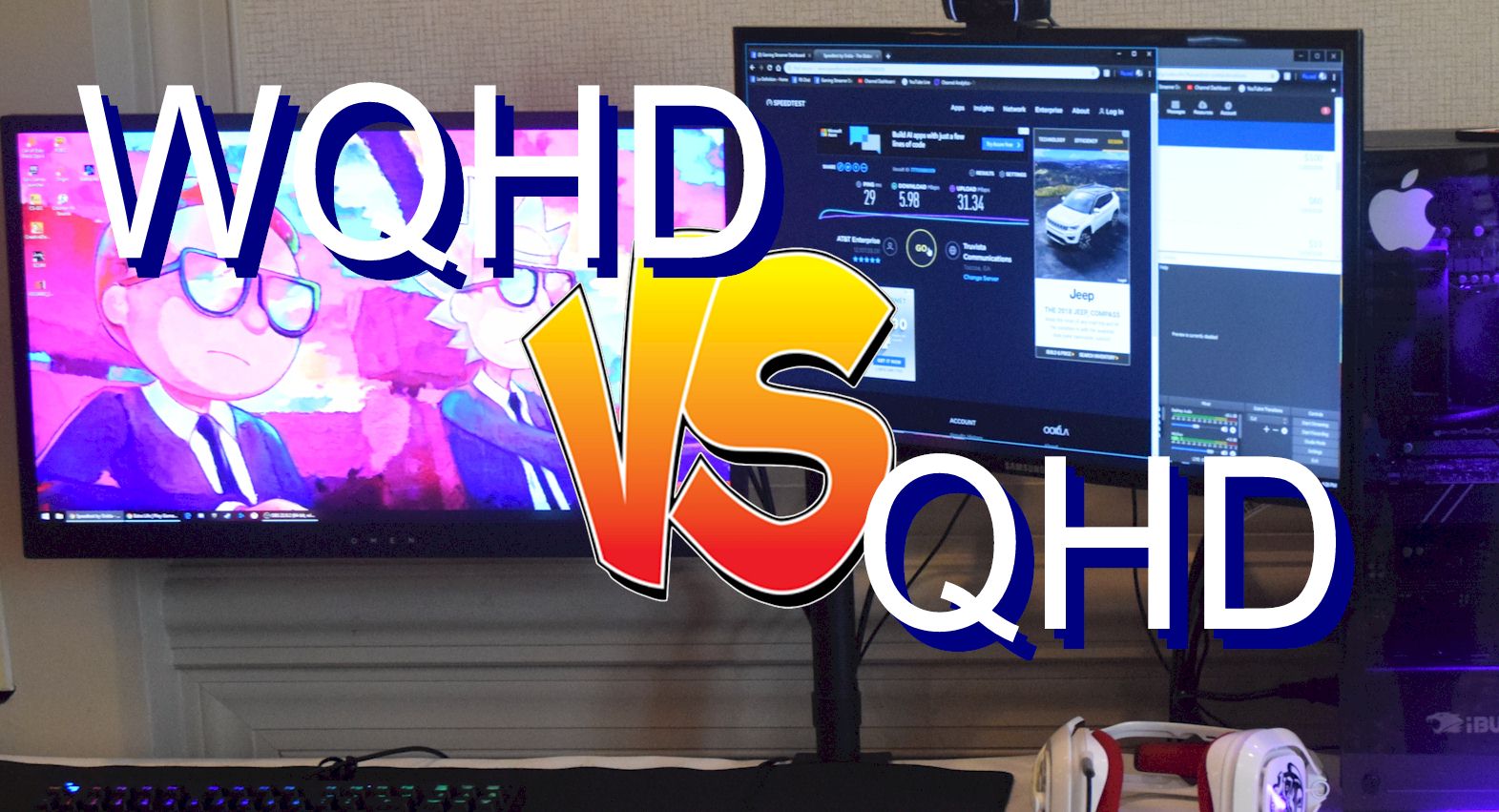One thing everybody is looking for when choosing a screen is screen resolution. From the time we shifted from the use of standard definition to High definition (HD), more screens are emerging, and we are still getting more confused with these screens. So for the guide today, we will give a comparison of WQHD Vs. QHD.
WQHD refers to Wide Quad High Definition, and QHD refers to Quad High Definition. Both QHD and WQHD are 1440p screens. The 1440p is also what is known as screen resolution. Screen resolution is measured in pixels. It is also used to rate the quality of screens.
I know the information provided above cannot help you choose the best screen for whichever purpose. Be it; gaming, movies, phones, and laptops. For that reason, I will be your superhero and tell you all about screen resolution and why it matters when choosing screens. Stay tuned!
Contents
Comparison between WQHD VS. QHD
Although WQHD and QHD are both 1440p screens, they both have different resolutions. So, what is the resolution of WQHD, and what does it mean?
WQHD has a resolution of 3440 × 1440 pixels. QHD, on the other hand, has a resolution of 2560 × 1440 pixels. These figures are not dimensions, rather, they are the number of pixels that can fit on a screen.
For example, you will find a 32-inches and 27-inches 2560 × 1440 pixels screen. You will also find a 34-inches and a 35-inches monitor with a resolution of 3440 × 1440 pixels.
If you are wondering how come other screens are large while others are tiny, yet they have the same resolution, you are in the right place. I will explain in detail what screen resolution is and how it affects the quality of your screen. I will use the table below on the differences between WQHD and QHD to explain this aspect further.
| Specifications | WQHD | QHD |
|---|---|---|
| Resolution | 3440×1440 pixels | 2560 × 1440 pixels |
| Price | Between $400-$500 | Between $200-$300 |
| Quality | Way clearer | A little bit dull |
| Refresh rate | 60-240Hz | 60-240Hz |
| Connectivity | Wi-Fi, Bluetooth, USB | Wi-Fi, Bluetooth, and USB connectivity |
| Adjustability | You can adjust the settings, can be mounted to a wall or placed on a stand | You can adjust the settings, can be mounted to a wall or placed on a stand |
| Panel technology | IPS LCD, nanolIPS, VA LCD | IPS LCD, nanolIPS, VA LCD |
Resolutions
WQHD has a screen resolution of 3440 x 1440 pixels. QHD, on the other hand, has a resolution of 2560 x 1440 pixels.
If you look at the table above, you can clearly see the only difference between the two screens is that WQHD has a resolution of 3440 horizontally.
The 880 pixels found in WQHD make the biggest difference in the screens. This means that; if you have two gaming monitors, each being the same size but different resolution. The screen with the larger resolution will be clearer than the one with less resolution.
So if you are planning to buy a larger screen, buy the one with a large resolution. It will be more careful and clearer because the Dots are closer.
Price
If you look at what you are getting on a screen and what your purpose is, then you better check the price difference. A 34-inch WQHD monitor and a QHD monitor of almost the same size have a price difference of about $100.
You can tell from the price difference the screen with the most resolution is a bit more costly than a screen with less resolution. So, if you are on a tight budget, go for the QHD screen. However, if you want to enjoy all the good qualities of 2k resolution screens, go for WQHD screens.
Qualities
Are you one of those people who is always adjusting the settings of your screen all the time? Then we have good news for you. If you want a screen that will bring all the details intended by the screen, then match the resolution with size.
For example, if you are given a choice to choose a 34 Inch screen that costs $500, and the other costs $100, you will be drawn to the screen that costs $100. Bring drawn to cheap means you are not getting quality.
If you are tight on budget, buy a smaller screen that works best with 1440p pixels.
2560 x 1440 pixels works best for a screen 27- inches and below.
Refresh rate
The refresh rate is the time taken by your screen to create a new image. However, both screens can accommodate a 60-240Hz refresh rate, each screen work best at a different rate.
For example, if you are doing some office work, you can keep the refresh rate somewhere between 60-75Hz. If you are using your monitor for gaming, a 144 – 240Hz refresh rate is ideal. This goes for both WQHD and QHD.
However, a WQHD can accommodate a large refresh rate than a QHD. This is because of the extra 880 horizontal pixels on WQHD.
Similarities between WQHD and QHD
Although the two screens have their difference, they have some similar features.
Connectivity
Since most of the monitors can be used for work and gaming, they have a few USB ports for keyboard, mouse, and even flash drive connectivity. They also allow Bluetooth and Wi-Fi connectivity.
Adjustability
Ideally, you want a monitor that can be mounted on a wall or placed on a stand. Both QHD and QHD wide 1440p screens come with a stand that can be adjusted in terms of angles and height. An option to remove the stand and mount the screen on a wall is available.
You also get to enjoy adjustable settings on both screens.
Panel technology
Depending on the brand of the monitor, you will find screens that utilize IPS LCD and other VA LCD. However, most monitors are IPS panels. Due to the advancement in gaming, some brands are using nano IPS panels.
Pros and cons
Although the two screens have one major difference, they also share done advantages and disadvantages. We will look into the pros and cons of each of the screens.
Pros of WQHD
- Can accommodate a refresh rate of 60 – 240Hz.
- It allows downgrading of the 1440p to 1080p.
- You will get clear images on a contrast ratio of 16:9.
- WQHD screens are worth every coin.
- The ideal screen size for WQHD is 34 inches which is wide enough for gaming, work, or even movies.
- It is wider than QHD.
Cons of WQHD
- The images are a bit dull than those in 4k resolution.
Pros of QHD
- Allows downgrade to 1080p.
- Can show clear and sharp images on screen size 27- inches and below without strain. There are other screens that are wider than 27- inches and still operate will with a resolution of 2560×1440 pixels.
- These screens are quite affordable.
- Utilize the IPS panel technology.
- QHD screens are adjustable.
- Most QHD screens allow USB, Wi-Fi, and Bluetooth connectivity.
- Can accommodate a refresh rate of 60 – 240Hz. However, you can adjust the refresh rate based on the size of the screen.
Cons of QHD
- You will get strained images with blackened sides on wide screens compared to WQHD screens.
- Has half the resolution of 4k screens.
Do the pixels bring a difference in the screens?
If you read all the segments above, you can clearly tell the main difference is brought about by the additional 880 pixels found on WQHD screens.
What the additional pixels mean is that the WQHD screen will display a sharper and brighter one at a contrast ratio of 16:9 without straining. Although QHD screens are also bright and clear, you might notice some black screens at the sides.
If you want to get the best out of the two screens, buy the perfect screen size. For QHD, the screen size should be between 24 – inches and to 27 – inches. At the same time, WQHD works best with screen size 34 or 35 inches. If you want to buy a screen larger than 35 -inches, then you should consider those with a higher resolution.
One advantage of these two screens is that you can downgrade the 1440p to 1080p.
Between QHD and WQHD, which is better?
Depending on what your purpose is, we can say the two screens are worth it. The only difference between the two is that WQHD is the wider version of QHD. This means that you will be getting clear images on large WQHD screens than on large QHD screens.
If by any chance, you like large screens but you are on a budget, you can get a QHD screen and reduce the 1440p resolution to 1080p. However, this means you will not be getting the same quality provided by a smaller QHD screen.
Although the price and the size of the two screens differ, they offer the same deal.
- They both can accommodate 60 -240Hz.
- You can get a wider range of screens with these resolutions.
- They both utilize IPS panel technology.
- You can enjoy a wide range of uses; Gaming, working, and even watching movies from both screens.
- And, these screens display better images than what was offered by standard definition screens.
So, your need will determine which screen you will buy. For example, buying a phone with 3440× 1440 pixels will not make sense. Phone screens are smaller and can accommodate even 1080p resolution.
It is worth knowing that QHD and WQHD are not the only screen resolutions available. You can check the 4k and 8k screens. 4k and 8k screens are what professional gamers and movie screens use to entice their clients. Therefore, if you are planning to start a gaming business, choose the latter. However, QHD and WQHD screens are ideal for home use.
Related:
- RPX VS IMAX
- 4DX VS IMAX
- IMAX VS Standard
- Dolby Cinema VS IMAX
- ScreenX VS IMAX
- Cinemark XD VS IMAX
- IMAX VS 3D
- D-Box VS IMAX
- PCM Vs Dolby Digital
- DTS NEO 2.5 Vs Dolby Digital
- WQHD VS. QHD
- 16:9 vs. 4:3 Aspect Ratio
Conclusion
As more are emerging, the different resolution they can accommodate is expanding. A decade ago, only standard definition screens were available. As for now, you will get QHD, full-range high definition, WQHD, 4k, and 8k screens.
Each of the new screens comes with amazing features that were not available on other screens before.
In the guide QHD Vs. WQHD screens, the two screens are almost the same thing. The only difference is in the wideness. WQHD is the wider version of QHD.
If you want to enjoy the features of both screens as intended by the manufacturer, buy a smaller QHD screen or a wider WQHD.
In general, WQHD screens can fit 880 extra pixels horizontally compared to QHD screens. This makes them a little bit more expensive than QHD.

Graduated with a Bachelor of Audio Engineering and Sound Production. He has worked with a number of studios as a Recording Engineer, with over 10 years of servicing experience in both re-recording mixing and sound editing.


QHD = WQHD = 2560×1400 pixels.
UWQHD = 3440×1440 pixels